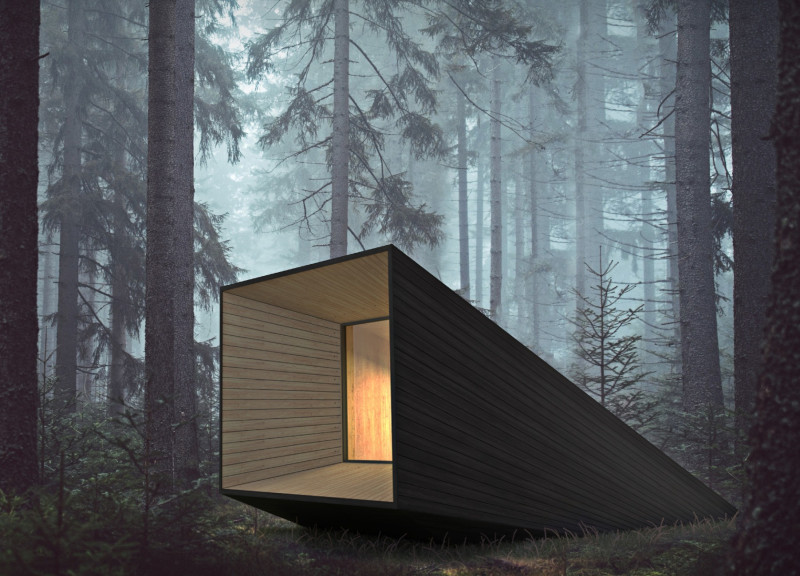5 key facts about this project
The Silence Amplifier is a project located within the tranquil forests of Latvia, designed to create a dedicated space for reflection and mindfulness. This architectural work focuses on amplifying the sounds of nature, fostering a deeper connection between the user and the surrounding environment. The building's form and materials are selected to enhance sensory engagement while maintaining harmony with its natural surroundings.
The architectural design takes the shape of a triangular prism, providing a modern aesthetic that both contrasts and complements the existing forest landscape. The exterior is clad in blackened timber, a choice that ensures durability while visually integrating the structure with the dark hues of the surrounding trees. Large windows strategically positioned throughout the design frame views of the forest, inviting occupants to engage with nature.
A key feature of the Silence Amplifier is its sound amplification system, which captures and enhances ambient forest sounds through strategically placed microphones. This system is complemented by dedicated meditation zones within the cabin, equipped with comfortable seating and natural lighting to encourage mindfulness practices. The space is structured to prioritize reflection, quiet conversation, and interaction with nature rather than distraction or stimulation.
The project represents a thoughtful response to the increasing need for quiet spaces in an increasingly noisy world. The design prioritizes sustainability through the integration of renewable resources, including a freshwater harvesting system that captures rainwater. Heating is provided by a wood stove, promoting a low-carbon footprint. The use of natural materials throughout, such as thermally modified wood and light-colored interior paneling, creates an atmosphere conducive to relaxation.
Unique Design Approaches to Sensory Engagement
The Silence Amplifier distinguishes itself through its innovative approach to environmental interaction. Unlike traditional cabins, this project actively facilitates an immersive auditory experience. The sound amplification system, which employs high-fidelity microphones, connects users to the subtleties of forest life, from the rustle of leaves to the calls of wildlife. This feature not only enhances the experience of the space but also promotes a deeper appreciation for natural soundscapes.
Additionally, the architectural layout incorporates flexible spaces that can be adapted for various activities, including meditation and group discussions. This versatility contrasts with conventional designs that often limit their functionality. Furthermore, the use of blackened timber for exterior cladding not only offers weather-resistant properties but also disrupts the traditional aesthetic approach to cabin architecture, pushing the boundaries of how such structures can be conceived in woodland settings.
Integrating Sustainability and Minimalism in Design
The architectural design of the Silence Amplifier emphasizes minimalism and sustainability, focusing on a reduced environmental impact. The choices of materials reflect a commitment to ecological responsibility, with an overarching goal of minimizing the carbon footprint. All aspects of the structure, from the energy-efficient LED lighting to the selection of recycled materials for furnishings, align with contemporary sustainable practices.
The cabin’s design also emphasizes simplicity and functionality. By stripping away unnecessary embellishments, the architecture directs attention to its purpose: creating a sanctuary for reflection and connection with nature. The use of natural light and open spaces enhances this intent, inviting users to engage directly with their surroundings without distraction.
For those interested in understanding the nuances of this architectural design, exploring the project presentation will offer deeper insights into the architectural plans, sections, and designs that underpin the Silence Amplifier. Engaging with these elements can provide a clearer picture of how the project integrates architectural ideas with a strong sense of place.



























